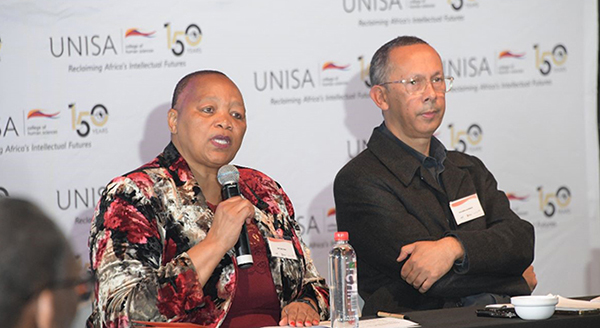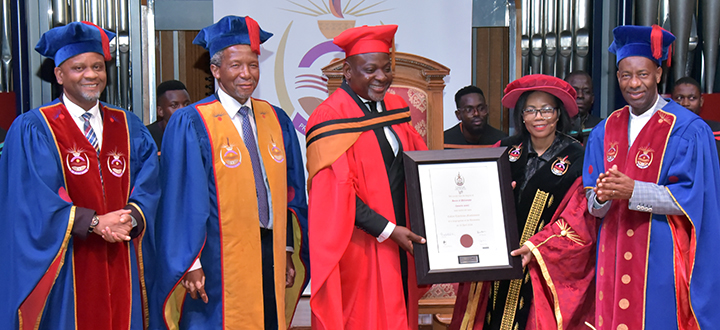College of Human Sciences
Collaborative efforts to address injury mortality in South Africa
Injury mortality rates in South Africa exceed global averages, with far-reaching consequences for affected families and communities, especially considering the strain on the country's healthcare system. To address this pressing issue, the South African Medical Research Council (SAMRC), the Mpumalanga Department of Health and Unisa, held a transformative colloquium on “Injury Mortality Surveillance: 2019 to 2022” in Mpumalanga.

Prof Zethu Nkosi (College of Human Sciences, Unisa) and Prof Ashley van Niekerk (Institute for Social and Health Sciences, Unisa)
In her welcoming address, Unisa’s Acting Executive Dean of the College of Human Sciences, Prof Zethu Nkosi, said: "In South Africa, injury is part of our significant and far-reaching threat." Nkosi added that the event aimed to analyse and discuss recent findings, reflect on the impact of Covid-19 and showcase the province's efforts in addressing injury mortality.
Representing the Mpumalanga Member of the Executive Council (MEC) for Health, Dr Mahlane Phalane, emphasised the importance of disseminating information presented during the colloquium to communities in Nkomazi, Mdantsane, Pongola, Sekhukhune and across South Africa. He highlighted that information is power, and stressed the need for such data to reach the people affected, rather than being confined to academic journals or restricted to academic discourse.
The colloquium offered valuable insights into injury patterns, particularly during the Covid-19 pandemic and post the period. Relating to the 2030 National Development Plan (NDP), the release of the National Information Management and Support System Reports (NIMSS) for 2019 to 2022, provided an opportunity to discuss changing and current patterns of road traffic crashes and violence. The findings could potentially inform Mpumalanga's policy and intervention strategies.
Phalane acknowledged the progress made in the province’s health sector. However, he stressed the need for further efforts to achieve the NDP goals by 2030, particularly in the injury and violence contexts. He further expressed hope that the colloquium would demonstrate the usefulness of injury surveillance in identifying critical research questions and improving injury prevention measures. The experiences shared by the Mpumalanga province would also benefit other provinces collecting injury mortality information and national partners considering broader countrywide approaches to surveillance.
Collaborating with various partners in the Department of Health, including the Mpumalanga Forensic Pathology Services, and the Limpopo, North-West and Gauteng provinces, SAMRC and Unisa aimed to enhance data collection technology, improve data system performance and efficiency, strengthen partnership capacities, and develop effective dissemination strategies. These collaborative efforts would address the country's need for timely and comprehensive injury mortality research, which became even more apparent during the recent Covid-19 lockdowns.
Additionally, the colloquium played a crucial role in providing updates on technological innovations and real-time data efforts, and discussing the research and policy implications of the current work. By examining the impact of Covid-19 and showcasing Mpumalanga's initiatives, the event addressed critical barriers to effective treatment, support and prevention programming in the post-lockdown period.
Moving forward, it is hoped that the knowledge shared during the colloquium will lead to the formulation of evidence-based interventions and policies to reduce injury mortality rates in Mpumalanga and across South Africa. With a concerted effort, informed by surveillance data and collaborative partnerships, it is possible to make significant progress in safeguarding the health, safety, and security of citizens.
#Unisa150
* By Tebogo Mahlaela, Communication and Marketing Specialist, College of Human Sciences
Publish date: 2023-06-07 00:00:00.0

 Community champion and agricultural entrepreneur extraordinaire honoured by Unisa
Community champion and agricultural entrepreneur extraordinaire honoured by Unisa
 Ghanaian-born Swede earns PhD in Information Sciences from Unisa
Ghanaian-born Swede earns PhD in Information Sciences from Unisa
 Unisa awards honorary doctorate to exemplary philanthropist and entrepreneur Collen Tshifhiwa Mashawana
Unisa awards honorary doctorate to exemplary philanthropist and entrepreneur Collen Tshifhiwa Mashawana
 Inhlanyelo Hub explores financing and sustainability at the International Conference on Business Incubation
Inhlanyelo Hub explores financing and sustainability at the International Conference on Business Incubation
 Unisa remains anchored among the waves
Unisa remains anchored among the waves